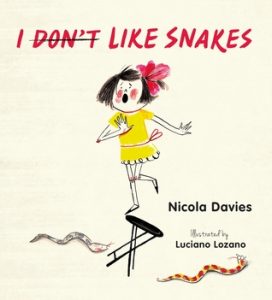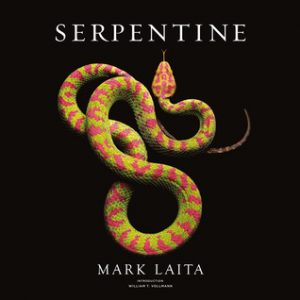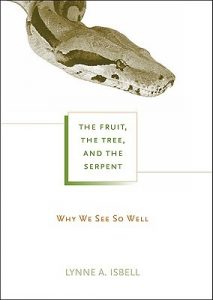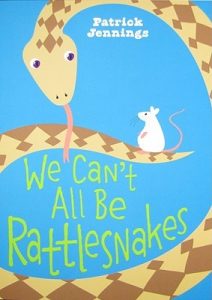 Do you like snakes? Have you met The Dude (resident snake at Civic Centre Resource Library)? He’s adorable and is sure to change your mind about snakes, if your answer to the first question was “no”! If you’re not quite up to using exposure to get you over your fear of snakes, then maybe this book will do the trick: I (Don’t) Like Snakes by Nicola Davies (who is also the author of Poop, Tiny Creatures, Extreme Animals, and Just Ducks!, to name a few), illustrated by Luciano Lozano.
Do you like snakes? Have you met The Dude (resident snake at Civic Centre Resource Library)? He’s adorable and is sure to change your mind about snakes, if your answer to the first question was “no”! If you’re not quite up to using exposure to get you over your fear of snakes, then maybe this book will do the trick: I (Don’t) Like Snakes by Nicola Davies (who is also the author of Poop, Tiny Creatures, Extreme Animals, and Just Ducks!, to name a few), illustrated by Luciano Lozano.
This is kind of an odd book, in that I’m not sure whether it’s supposed to fall within the picture book market or the junior non-fiction one, because while there’s a story to it and it’s definitely a book filled with illustrations, Davies also includes lots of information about snakes, from the way they move around to how they molt their skin. One thing’s for sure though: the illustrations are adorable. And! The moral of the story, I think, is not only that snakes are awesome, though they are (maybe in both the colloquial and traditional sense of the word, at that), but that sometimes, hatred stems from ignorance, and that’s a takeaway message filled with hope and a healthy dose of optimism, because that’s something we can take into our own hands – all the more so at the library!
I’m going to move onto a number of books about snakes so that once I (Don’t) Like Snakes starts up your curiosity for all things anguine, you’ll be able to whet your appetite with some of the following.
Well for one, here’s a link to materials we have about snakes all throughout our system: non-fiction (all ages) and fiction (all ages). I’ve picked out a couple of them from those two lists to talk about below:
 Mark Laita photographs snakes across the world to showcase their beauty for the world to see in Serpentine. It reminds me a bit of the way in which Susan Middleton photographs the invertebrates that live in the ocean in Spineless, except these are all photographed against a beautiful black velvet backdrop and you’ll have to flip all the way to the back to find out what each of them are. The snakes in Serpentine take various forms and positions and the focus is completely on the snakes: what they are and how they move. It’s really quite beautiful. The textures Laita captures are just stunning, and seeing the vibrant colours of the body that become apparent as the scales shift in motion is a real treat. The snakes featured come in all sorts of shapes and sizes, including a brood of eggs and some young’uns, and – one of my personal favourites – a skeleton of a boa constrictor. I never knew there could be so many varieties of finishes to snakes, either! By which I mean, some of them look so glossy as to reflect the light Laita aims at it, and others seem to simply absorb the light and reflect matte.
Mark Laita photographs snakes across the world to showcase their beauty for the world to see in Serpentine. It reminds me a bit of the way in which Susan Middleton photographs the invertebrates that live in the ocean in Spineless, except these are all photographed against a beautiful black velvet backdrop and you’ll have to flip all the way to the back to find out what each of them are. The snakes in Serpentine take various forms and positions and the focus is completely on the snakes: what they are and how they move. It’s really quite beautiful. The textures Laita captures are just stunning, and seeing the vibrant colours of the body that become apparent as the scales shift in motion is a real treat. The snakes featured come in all sorts of shapes and sizes, including a brood of eggs and some young’uns, and – one of my personal favourites – a skeleton of a boa constrictor. I never knew there could be so many varieties of finishes to snakes, either! By which I mean, some of them look so glossy as to reflect the light Laita aims at it, and others seem to simply absorb the light and reflect matte.
The photos are occasionally coupled with a quote on the opposite page on the topic of good and evil, which I have mixed feelings about since, 1) it presupposes snakes should be viewed in light of such a theme, and 2) I’m not the biggest fan of the formatting of these quotes, especially when it comes to the colours; but there isn’t much else that distracts you from viewing the snakes. There is an introduction written by William T. Vollmann, as well as a visual glossary of all the snakes featured within the book, telling you about each snake’s basic information, including their name, family, habitat, how they breed, and the like. Part of me questions whether talking so plainly about good and evil in conjunction with snakes helps to perpetuate the issue somewhat, because why can’t we discuss snakes without talking of them being either evil or not necessarily evil, but at the same time, these strikingly beautiful photographs will probably do wonders in helping sway those who might be on the fence, or have preconceptions about how snakes are vile and ugly creatures. This coffee table book would be a lovely addition to any home (for a good 3 weeks, at least), and the constant presence of snakes within the home might help to foster discussion about what might be pretty widespread negative views on snakes.
 On the other hand, maybe there is something in the fear of snakes being a top-ranking fear worldwide? Is the fear of snakes innate? (The jury’s still out on this from what I can see.)
On the other hand, maybe there is something in the fear of snakes being a top-ranking fear worldwide? Is the fear of snakes innate? (The jury’s still out on this from what I can see.)
Isbell Lynn makes a pretty compelling argument in The Fruit, The Tree, and the Serpent about how the development of sight in human beings, as well as our propensity for pointing at things, might have been influenced by, among other things, predation pressures from snakes. This book isn’t written for the general public, I’ve got to point out, and if you aren’t used to reading scholarly articles, it might take a bit of getting used to both the way Isbell writes, as well as getting yourself more comfortable reading through the topic as you go along. It’s an interesting topic, though, and you get to learn a lot about theories concerning human evolution, especially with regards to the development of our visual system, and how our surroundings – both animate and inanimate – drove both the development of our sight as well as our capacity for language.
This book isn’t for the faint-hearted as far as content density goes, but it’s certainly an interesting hypothesis!
 I’m going to end with what sounds to be a funny, wryly written novel by Patrick Jennings about a boy, Gunnar, who catches a wild snake and places the snake (whom he names Crusher) into a tank in order to watch her eat. We Can’t All Be Rattlesnakes is told from the perspective of Crusher, who absolutely refuses to accept her situation and starts a hunger strike, disappointing all of Gunnar’s expectations – well I mean, to begin with, she’s not even a rattlesnake as he thinks she is, so we’re already off to a rocky start! – but endearing her infinitely to the reader as she befriends a mouse Gunnar drops in for her breakfast (and thus is forever named Breakfast) and plans her escape. I have yet to read it, but it sounds like an interesting premise, and promising also for maybe touching upon the ethics of catching and keeping animals.
I’m going to end with what sounds to be a funny, wryly written novel by Patrick Jennings about a boy, Gunnar, who catches a wild snake and places the snake (whom he names Crusher) into a tank in order to watch her eat. We Can’t All Be Rattlesnakes is told from the perspective of Crusher, who absolutely refuses to accept her situation and starts a hunger strike, disappointing all of Gunnar’s expectations – well I mean, to begin with, she’s not even a rattlesnake as he thinks she is, so we’re already off to a rocky start! – but endearing her infinitely to the reader as she befriends a mouse Gunnar drops in for her breakfast (and thus is forever named Breakfast) and plans her escape. I have yet to read it, but it sounds like an interesting premise, and promising also for maybe touching upon the ethics of catching and keeping animals.